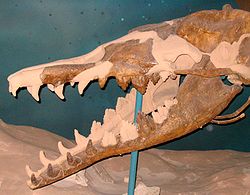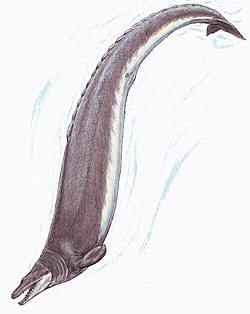Basilosaurus sp. (fossil whale) (Eocene; Egypt) 5 (32221132001)
Basilosaurus sp. - fossil whale pelvis and hind limbs (casts) from the Eocene of Egypt. (public display, Field Museum of Natural History, Chicago, Illinois, USA)
From museum signage: "At the water's edge, whales were making a big move: from land to sea. It's one of evolution's most fascinating stories. Whales are ocean mammals that started out as land mammals. Four-footed predatory mammals hunted in and around the waters of Asia's ancient coastline more than 50 million years ago. Over time, these creatures came to depend more on food from the sea than food on land. As they became adapted for life in the water, feet evolved into flippers, and whales left the shores for good. What's more, fossils tell us these ancient whale ancestors were four-footed mammals with hooves.
Feet became flippers in just ten million years. From land-dwelling ancestors, the first whales evolved for life spent partly on land, partly in the sea. With webbed feet, they could swim; with long limbs, they could move about on shore. But food was abundant in the seas. Within ten million years, whales were fully aquatic. Webbed front feet evolved into paddle-like flippers. Hind limbs all but disappeared, as a broad tail fluke evolved for more powerful swimming.
Whales today do not have feet, so of course they don't have hooves. So how do we know whales' ancestors had hooves? There are a couple clues. In fossils of some early whales, there are hoof-like claws on the feet. But an even better clue is in the ankles. Fossils show that ankles of early land-dwelling whales share a unique structure with ankles of certain hoofed mammals that live today. The grooves at each end of an early whale's ankle bone are unique to the ankles of a group of hoofed mammals called artiodactyls, which includes camels, pigs, hippos, and antelopes. The grooves prevent side-to-side movement of the ankle - certain hoofed mammals can only move their ankles forward and backward.'
This display explores the fossil clues that whales evolved from a hoofed mammal ancestor that walked on land. But fossils are no longer the only clues supporting this theory. DNA provides others. Genetic studies indicate that whales' closest relatives are the group of hoofed mammals called artiodactyls."
"[The early whale] Basilosaurus had only tiny hind limbs and a pelvis - no longer needed for weight-bearing - detached from its spine." Classification: Animalia, Chordata, Vertebrata, Mammalia, Artiodactyla, Cetacea, Archaeoceti, Basilosauridae
See info. at: <a href="https://en.wikipedia.org/wiki/Basilosaurus" rel="nofollow">en.wikipedia.org/wiki/Basilosaurus</a> and
<a href="https://en.wikipedia.org/wiki/Basilosauridae" rel="nofollow">en.wikipedia.org/wiki/Basilosauridae</a>Relevantní obrázky
Relevantní články
BasilosaurusBasilosaurus byl rod dravých kytovců žijících v pozdním eocénu. Dosahoval délky až 20 metrů, pravděpodobně byl největším tvorem své doby. Měl štíhlé protáhlé tělo, lebku s nápadným rozlišeným chrupem, přední končetiny (ploutve) stále ještě ohebné v lokti, a také zakrnělé, ale pohyblivé zadní končetiny. Hlavní pohybovou funkci měl ocas vybavený horizontální ocasní ploutví. Byl to vrcholový predátor, který lovil kořist pomocí velkých, v zadní části tlamy pilovitých zubů. .. pokračovat ve čtení









